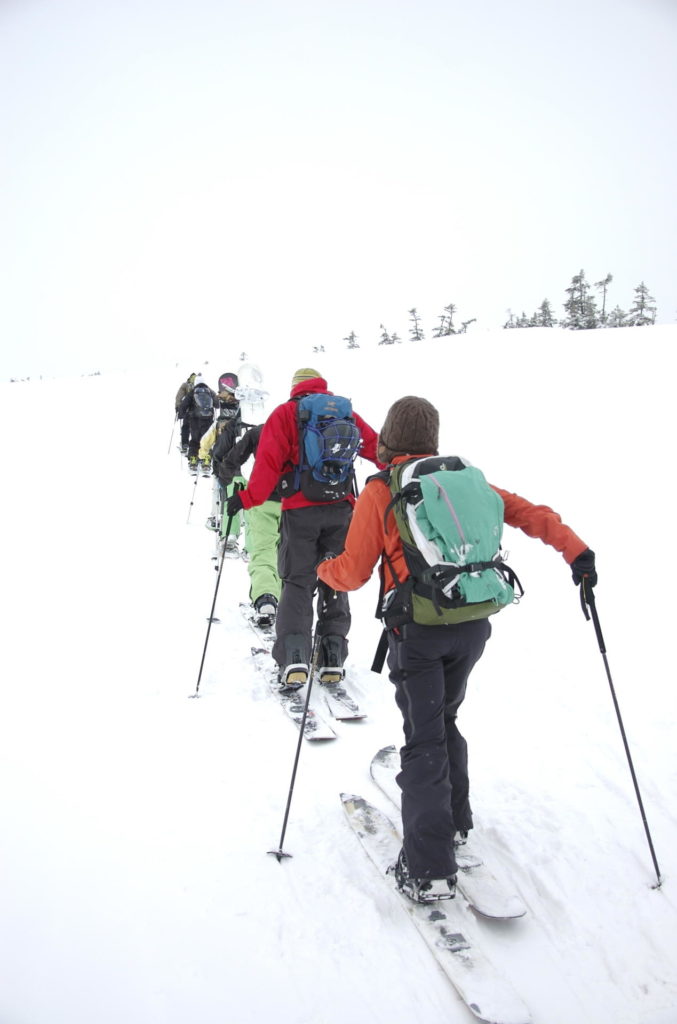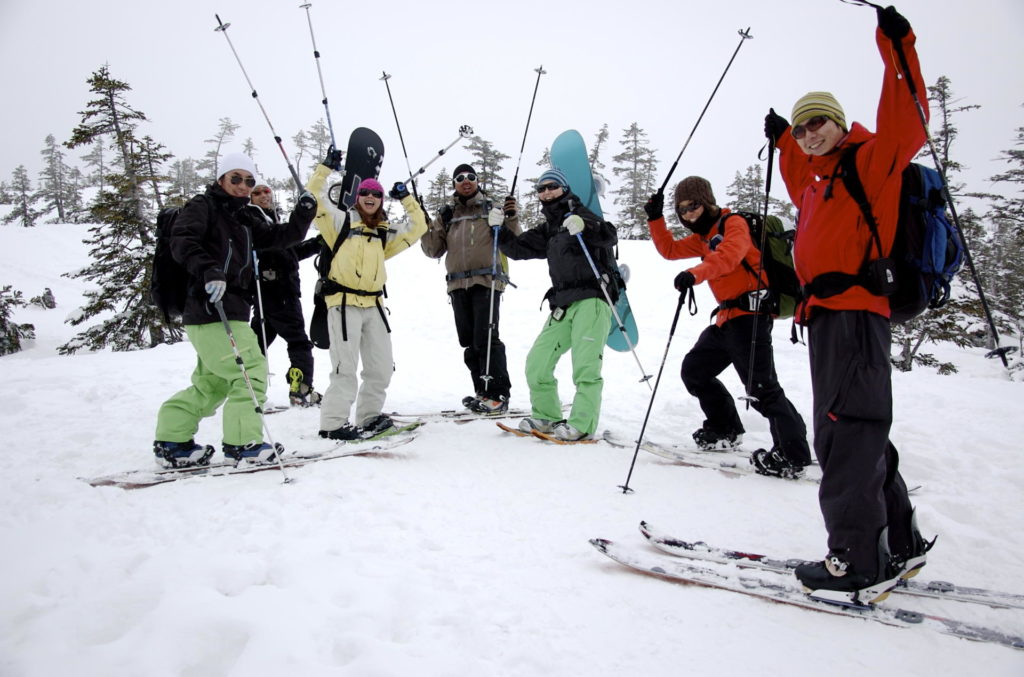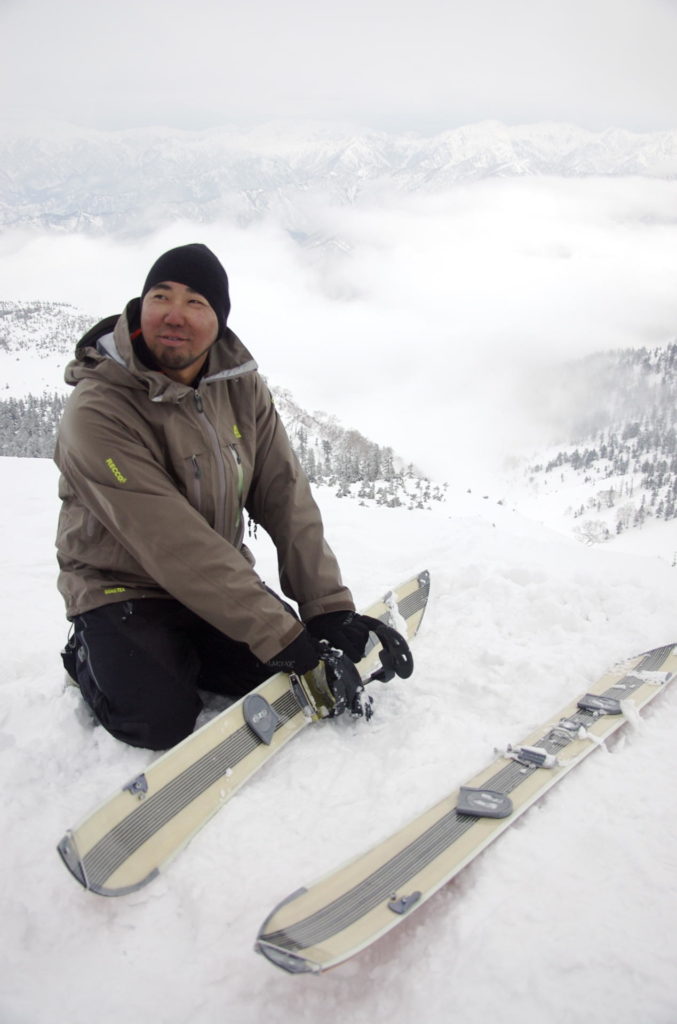It’s a bluebird day with a dusting of fresh snow. Over at neighboring Naeba, spring conditions are already evident but, here at Kagura, the slightly higher elevation and northerly breeze have kept 20 centimeters of pow fairly dry. Andrew Kelly and I spent most of the morning riding and shooting northerly-facing aspects of Kagura and eventually made it to the top two-man chair that accesses Kagura’s popular backcountry.


The chair usually doesn’t open until late spring. We pause here to take a few quick snaps of a group of snowboarders preparing to head into the backcountry. This is where we meet Takumi Nagai, an unassuming guy who runs a mountain guiding company called Tri Force.
It’s not every day you get invited into the backcountry by recent strangers, but things like this seem to happen in Japan. We talk with Nagai and quickly find him knowledgeable, professional and modest, characteristics that no doubt make him a great backcountry guide.
We also discover that he works as a product designer for Nike ACG and is part way through a Ph.D. in Snow Science at Niigata University. The best part is he designs and sells his own snowboards under the name Voltage.
These aren’t your average snowboards. Nagai’s most recent models are split in half. Those unfamiliar with recent developments in backcountry snowboarding may be wondering why you would want your board to split in two. Splitboarding is snowboarding’s answer to ski touring.
“The biggest advantage with splitboards is they are light weight when hiking, so you can easily access deep into the backcountry,” says Nagai.
In its most basic form, a splitboard is a snowboard sliced down the center, held together with a connection system at the nose and tail. The board is mounted with special bindings and binding plates that easily adjust your foot position from a standard snowboard stance to a forward-facing position.
Quicker and easier than snowshoeing, splitboarding is gaining popularity around the world for backcountry riding – particularly with the eco-conscious crowd who like to earn their turns.

The ability to attach skins to the bottom of your separated board, much like telemark and touring skis, allows speedier backcountry travel. Plus, you don’t have to actually carry your snowboard—an added bonus for which you’ll be thankful on long hike-ins.
Of course, splitboards don’t perform well in all conditions, but the Kagura backcountry is full of “cruisey” rolling terrain with long access hikes and plenty of dry, fresh snow—the perfect location for the Tri Force backcountry tours.
Nagai kindly invites us to come along on a tour the following day, so we meet the crew at 8 a.m. in the Sanroku Station car parking lot at the bottom of the Mitsumata Ropeway. After some friendly “hajimemashite,” and a few semi-awkward bow-handshake combinations on my behalf, we sort our gear, check and double-check for skins, transceivers, probes, shovels, poles, spare gloves, lunch and cameras and made some binding adjustments.
It was a multi-pitch mission to the top of Kagura via the ropeway, the gondola, and several chairlifts and skating in between. Once at the top, the board-splitting and de-layering begins. Sunnies and skins on, goggles and jackets off, it’s time to go. The three-hour journey is filled in with pleasing views and good conversation, as well as some silly stacks followed by fits of hysterics (by the splitboarding newbies) on some short downward pitches we encounter.
When we reach the top of our trek we have lunch and check out Nagai’s topographical map to see Kagura’s real potential while he tells us more about his boards and the trips he runs.
“Splitboarding is good for Japan because there are lots of mellow lines, and it frequently snows deeper than 50 cm. in one night. Long approaches in Japanese backcountry can be in very deep snow, so splitboarding is the answer,” Nagai exclaims.
We then gear back up for the trip down, check transceivers and began the jigsaw puzzle of putting the splitboards back together. Our enjoyable 30-minute ride down is over mellow, playful terrain; from wind-ruffled ridgelines to open powder faces, finally descending into the sticky spring snow of the lower gullies.
Done and dusted, we’re back in the car park by 2 p.m. sorting out gear and exchanging grateful goodbyes.
Choosing the Right Voltage
By Andrew Kelly
Niigata bears the brunt of some of Japan’s heaviest snowfall, and Voltage boards have grown out of this environment. Snowboarders in Japan often find their regular boards submarine in this deep snow and end up investing in powder-specific boards for those bottomless snow days. Recent board designs feature reverse camber and tapered boards, allowing more float in the deep stuff and more smiles on snow-covered faces.
However, it doesn’t matter what kind of board you have if it is strapped to your back, as when you are hiking into the backcountry. With the extra weight of your board, you also need to bring larger snowshoes to stay on top of the snow, but you do get to enjoy the cold snow showers when you clip tree branches with your board above your head.
While struggling with snowshoes through yet another deep day in the Niigata backcountry, Takumi Nagai knew there must be a better way. Inspired by the high mountain achievements of Jeremy Jones on a splitboard, he began designing his own boards to suit the terrain in Japan.
Splitboards eliminate the weight of carrying the board on your back and instead give you the floatation and glide of touring skis, making ascending much faster. Splitboards don’t have the torsional strength of a regular board, so you compromise stability across icy ridgelines or in variable snow conditions—something a pair of spiked snowshoes and a good freeride board handle well. As a result, splitboards designs have often been stiffer to make up for this, resulting in a solid but lifeless ride.
In his never-ending quest for the “perfect ride,” Nagai refused to accept that splitboards must ride like 2x4s bolted together. He has managed to make responsive boards that flex naturally and are fun to ride. In demand by everyone from top pro riders to weekend powder enthusiasts, Voltage splits look nothing like typical, unwieldy, backcountry longboard shapes.
Combinations of reverse camber in tips and tails, camber between the bindings and moderate taper give these boards all the benefits of current cutting-edge snowboard design, allowing shorter boards to float more in deep snow.
The Outback model has a twin-pointed shape for freestyle fun and a narrow waist inspired by the tight steep chutes of Tanigawa-dake. The tapered Flying Fish model features a shallow swallowtail that matches the split design well.
While Voltage’s regular boards are made in Japan, their splitboards are handcrafted in the Prior factory in Canada to Nagai’s original designs. Voltage team rider Takashi Minamiura has even been throwing backside 720s on his, hitting the park on his way home from the backcountry in Hakuba.
Collaborating with the “snowboard design geeks” at Spark R&D in Montana, Voltage is not a small local brand isolated in Japan, but rather part of a growing family of small rider-run brands, committed to making high quality products while shaping snowboarding in their own image
Select the shape you want and match it to whichever graphics you like from the Voltage 2011 range. You can even send them an e-mail with a specific request; it’s the closest you will get to a custom-made board without making your own.
The boards don’t come cheap, but this isn’t the kind of board you replace each year to match your new outerwear. When questioned about the ecological aspect of his company, he says people need to invest in equipment they can trust when entering backcountry with their own two feet. He adds, “Snowboards should not be disposable. A good splitboard will last for many years of riding.”
Tri Force
Tri Force specializes in backcountry snowboard tours. Customers can choose to snowshoe or splitboard, or even test one of Takumi’s own Voltage splitboards. Most of Tri Force’s trips are around the Kagura Ski Area in Yuzawa. These trips generally run between 5 and 8 hours with varying terrain depending on the group’s ability and conditions.
Other trips include Shigekurodane, from Tanigawadake Tenjindaira in Minakami, Gunma, to Tsuchitaru in Niigata. It’s a harder trip that accesses longer, steep lines. They also run multi-day trips in Gunma’s Oze area, staying at mountain huts along the way.
Web: www.triforce.ne.jp
“Of course, splitboards are not the only way. Boots with crampons are better for steep, crusty conditions. But, for long hikes and mellow lines, splitboards are great.”
—Takumi Nagai
“Riding powder is our inspiration. Our customers are powder junkies.” —T.N.




